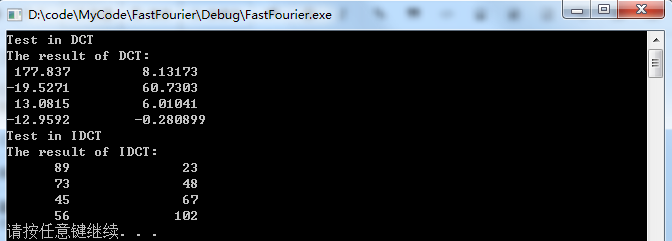C++实现离散余弦变换(参数为Eigen矩阵)
C++实现离散余弦变换(参数为Eigen矩阵)
问题描述
昨天写了一个参数为二维指针为参数的离散余弦变换,虽然改进了参数为二维数组时,当数组大小不确定时声明函数时带来的困难,但使用指针作为参数也存在一些不足之处,比如需要手动寻址、容易出现指针越界等。因此这篇文章中的代码对昨天的代码做了进一步的改进,将函数的参数设置为Eigen矩阵,很好的避免了上述问题。
DCT
代码的主体跟之前的代码没啥差别,主要就是改变了函数的参数类型
// DCT - Discrete Cosine Transform
void DCT( MatrixXd &input, MatrixXd &output )
{
cout<<"Test in DCT"<<endl;
double ALPHA, BETA;
int u = 0;
int v = 0;
int i = 0;
int j = 0;
int row = input.rows();
int col = input.cols();
for(u = 0; u < row; u++)
{
for(v = 0; v < col; v++)
{
if(u == 0)
{
ALPHA = sqrt(1.0 / row);
}
else
{
ALPHA = sqrt(2.0 / row);
}
if(v == 0)
{
BETA = sqrt(1.0 / col);
}
else
{
BETA = sqrt(2.0 / col);
}
double tmp = 0.0;
for(i = 0; i < row; i++)
{
for(j = 0; j < col; j++)
{
tmp += input(i,j) * cos((2*i+1)*u*PI/(2.0 * row)) * cos((2*j+1)*v*PI/(2.0 * col));
}
}
output(u,v) = ALPHA * BETA * tmp;
}
}
cout << "The result of DCT:" << endl;
for(int m = 0; m < row; m++)
{
for(int n= 0; n < col; n++)
{
cout <<setw(8)<< output(m,n) <<" \t";
}
cout << endl;
}
}
注意比较上述Eigen数组的访问方法。访问Eigen矩阵的i行j列元素是,使用的是(i,j)
IDCT代码
// Inverse DCT
void IDCT( MatrixXd &input, MatrixXd &output )
{
cout<<"Test in IDCT"<<endl;
double ALPHA, BETA;
int u = 0;
int v = 0;
int i = 0;
int j = 0;
int row = input.rows();
int col = input.cols();
for(i = 0; i < row; i++)
{
for( j = 0; j < col; j++)
{
double tmp = 0.0;
for(u = 0; u < row; u++)
{
for(v = 0; v < col; v++)
{
if(u == 0)
{
ALPHA = sqrt(1.0 / row);
}
else
{
ALPHA = sqrt(2.0 / row);
}
if(v == 0)
{
BETA = sqrt(1.0 / col);
}
else
{
BETA = sqrt(2.0 / col);
}
tmp += ALPHA * BETA * input(u,v)* cos((2*i+1)*u*PI/(2.0 * row)) * cos((2*j+1)*v*PI/(2.0 * col));
}
}
output(i,j)= tmp;
}
}
cout << "The result of IDCT:" << endl;
for(int m = 0; m < row; m++)
{
for(int n= 0; n < col; n++)
{
cout <<setw(8)<< output(m,n)<<"\t";
}
cout << endl;
}
}
测试代码
#include <iostream>
#include <math.h>
#include<cstdio>
#include <iomanip>
#include<algorithm>
#include<fstream>
#include<math.h>
#include<string>
#include <Eigen/Dense>
using namespace std;
using namespace Eigen;
#define PI 3.1415926
int main()
{
int i = 0;
int j = 0;
int u = 0;
int v = 0;
const int rows = 4;
const int cols = 2 ;
double inputdata[rows][cols] = {
{89,23},
{73,48},
{45,67},
{56, 102},
};
double outputdata[rows][cols];
MatrixXd minput;
MatrixXd moutput;
minput.setZero(4,2);
moutput.setZero(4,2);
for (int i = 0; i < minput.rows(); i++)
{
for (int j = 0; j < minput.cols(); j++)
{
minput(i,j) = inputdata[i][j];
}
}
DCT( minput, moutput );
IDCT(moutput, minput);
system("pause");
return 0;
}
运行结果

转载请注明出处:http://www.cnblogs.com/scut-linmaojiang/p/5016811.html



